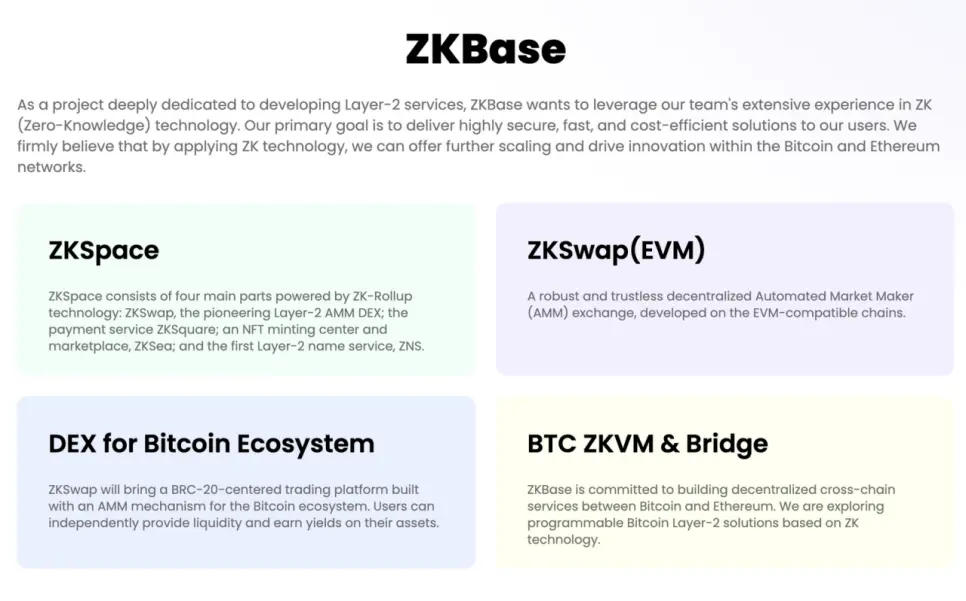Why does the market need ZKBase?
Author: Tommy

Generally, we can categorize projects in the Bitcoin ecosystem into two categories: "Asset Issuance Protocols" and "Scaling Solutions." Project teams typically focus on developing products and solving problems within one of these categories. This time, ZKBase is set to provide a comprehensive scaling solution for asset issuance protocols, which can better address the two main issues currently existing in the Bitcoin ecosystem: poor network performance and low liquidity of inscribed assets.
The ZKBase project team is very technology-oriented and does not overly embellish the RoadMap, instead emphasizing ZK solutions and security. When ZKBase's BRC20 AMM DEX gains a certain user base, the recently popular BRC20 IDO may also be something ZKBase can excel at.
Why does the market need ZKBase? Which protocols can ZKBase benchmark against?
The contradiction between poor liquidity of mid-to-long tail BRC20 assets and their inability to be listed on centralized exchanges
During the summer of inscriptions, a large number of so-called "meme inscriptions" with high wealth effects emerged. However, due to the P2P trading model of the inscription market, the liquidity of these assets is very low, making it difficult for centralized exchanges to provide market-making for such assets and challenging to list them. This makes it hard for holders of inscribed assets to exit in a timely manner, and large funds are reluctant to enter. The upcoming AMM ZKSwap supporting BRC20 assets from ZKBase aims to solve this problem, allowing the BRC20 market to have its own "Uniswap," which will greatly enhance the liquidity and capital efficiency of the market.
Currently, after a period of launch, Unisat brc-20 swap seems to have not gained a considerable user base, and this sector remains a vast blue ocean market.
BRC20 - ERC20 cross-chain bridge security issues.
In the cross-chain bridge sector, the most concerning issue for investors and users is security. In recent years, frequent cross-chain bridge incidents have led to significant losses for many users and project teams. In the newer sub-sector of BRC20 - ERC20 cross-chain bridges, there are also many known and unknown risks.
ZK technology focuses more on privacy and fast transaction processing, and it is a safer method. ZK Rollup submits new states to L1 along with proofs, inheriting L1's security guarantees, while the security of the BTC network is protected by a strong miner community, which is quite similar to Stacks after the Nakamoto upgrade.
Currently, the most well-known BRC20 - ERC20 cross-chain bridge, MUBI, lacks in privacy and security compared to ZKBase.
The well-known inherent flaws of the Bitcoin network
The limitations of the Bitcoin network are very obvious: slow network speed, high transaction fees, and no support for complex smart contracts and DApps. At this point, Layer 2 needs to step in to solve this problem by building an additional layer that communicates with the Bitcoin chain to achieve broader application scenarios while maintaining the high security of the Bitcoin network.
The established BTC Layer 2 public chain, Stacks, enjoys compliance advantages (Stacks became the first public project to obtain compliance certification from the U.S. SEC in Q3 2019), but such a compliance narrative is not appealing in the current market and cryptocurrency development trends. At the same time, the niche nature of the Clarity language in the Stacks ecosystem has also led to difficulties in increasing developer activity, and Stacks has seen slow growth in attracting developers and users. Over the years, Stacks' development seems to have stagnated, and to this day, no well-known projects have emerged in its ecosystem.
With the backing of ZK technology and focusing on the hot topic of BRC20, ZKBase has the potential to break out in a very short time.
Market predictions suggest zkSync may issue tokens in the first half of 2024, benefiting the zk sector
In December, zkSync surpassed Ethereum's mainnet in the number of transactions over the past month. On December 28, L2Beat data showed that zkSync processed 34.7 million transactions in the past 30 days, surpassing Ethereum's mainnet's 34.2 million transactions during the same period; another highly anticipated high-funding project, LayerZero, has officially announced it will issue tokens in the first half of 2024…
Therefore, the market predicts that the first half of 2024 will be an excellent opportunity for zkSync to issue tokens and airdrops. If zkSync's TGE occurs, it will bring a massive influx of funds and TVL growth to its ecosystem, directly benefiting various projects within the ecosystem.
Comparing to the Arbitrum airdrop before its distribution, the excitement of Arbitrum Summer from January to March 2023: Camelot (GRAIL) rose from $200 to $4,000, MAGIC from $0.5 to $2, RDNT from $0.04 to $0.45…
If zkSync can replicate the wealth effect of Arbitrum before and after its token issuance, in the current early stage of the bull market, the overall L2 sector may see FOMO sentiment push this magnitude even higher, making the overall investment odds very favorable.

Innovative projects in the Bitcoin ecosystem will be rewarded by the market
In addition to the wealth myths of inscription tracks like BRC20 and ARC20, projects focused on infrastructure construction in the Bitcoin ecosystem have also reaped substantial rewards:
The star cross-chain bridge project BRC20-ERC20, MUBI, completed its auction in nearly 30 minutes, with a maximum increase of over 20 times on the same day, and it rose 1455% within a month; the token BSSB of the decentralized stablecoin protocol Bitstable, based on the Bitcoin network, rose over 45 times compared to its IDO price; the BRC20 IDO project BitcoinCats from BakerySwap saw oversubscription of 150 times, with subscription funds exceeding $100 million, making it extremely popular, and the final results indeed brought good returns to investors; FOOX and Zooopia on TurtSat reached prices nearly 30 times and 100 times their issuance prices; even the NFT lending project BendDAO, which pivoted to BRC20, saw a surge in token price after announcing its entry into the Bitcoin ecosystem.
Currently, after experiencing a wave of decline, MUBI's circulating market cap equals its total market cap, still standing at $200 million. In contrast, ZKBase, with a more comprehensive future product lineup and a stronger technical background, holds great promise.









